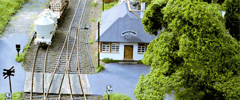Introduction
Let's turn to the base of common operation: the modules. A module is a piece of model railway, designed according to the creator's own wishes, which can be connected via standardized ends with other modules. In general, the required length of a module is not defined, but the owner should consider his/her personal limit of transportation. A length from 750 to 1100 mm is reliable. If the chosen theme is to long, it can be separated in several segments. For the width see Modules: Frame, for the height Modules: Legs.
The most important types of modules:
- Route:
This is the simplest but also most important type of modules: Between two ends a "normal" track (without junctions) is created, shaped either strait or bend or in some other way.
- Signal module:
A route module with a home signal or block signal (or the adequate distant signal respectively). Universal usable signal modules are reliable.
- Station and stop:
All connections to industrial plants, junctions and stations of cause.
- Fiddle yard:
This is the endpoint of a route of modules. It serves mostly for marshalling. Furthermore fiddle yards simulate the "big, wide world", ergo that part of the route which can not be illustrated with the layout anymore. A fiddle yard has to have an appropriate number of tracks, connected to one end of the route. There must be a possibility to change over locomotives (transfer table, turn table), to avoid damage on vehicles by the "five-finger-crane". It does not need to have a scenery.


